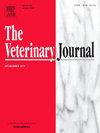Feasibility of a simultaneous ultrasound (US) and peripheral nerve stimulation (PNS) guided interscalene brachial plexus injection in calves
IF 3.1
2区 农林科学
Q1 VETERINARY SCIENCES
引用次数: 0
Abstract
The feasibility of a simultaneous ultrasound and peripheral nerve stimulation (PNS) guided interscalene brachial plexus injection was investigated in 6 calves, using three different techniques (2 calves per group, bilateral injections). Group 1: one aliquot of 0.3 mL/kg administered near the ventral branches of the eighth cervical/first thoracic (C8-T1) nerves. Groups 2 and 3: two aliquots of respectively 0.15 mL/kg and 0.3 mL/kg, one administered near C8-T1 and one near the ventral branches of the sixth/seventh cervical (C6-C7) nerves. The calves were sedated (0.2 mg/kg xylazine intramuscularly and 2 mg/kg ketamine intravenously) and positioned in lateral recumbency. Following aseptic preparation, a linear ultrasound probe was positioned at the shoulder level, transversely oriented to the longitudinal axis of the first rib. The ventral branches of C8-T1 and C6-C7 were visualised between the scalene muscles, and a 20 gauge insulated needle connected to a PNS was inserted in-plane until near the target nerves. A dye solution was injected once the motor response was absent below 0.4 mA stimulus. The procedure was repeated in the contralateral limb, and the calves were euthanised (70 mg/kg pentobarbital intravenously). Dissection was performed to assess nerve staining (Not stained, Poor, Partial or Complete circumference with at least 1-centimetre length).
Results
C8-T1: 3/4 completely and 1/4 partially stained (all groups). C6-C7: 0/4; 2/4; 4/4 partially, 3/4; 2/4; 0/4 poor and 1/4; 0/4; 0/4 not stained in groups 1, 2 and 3, respectively. In conclusion, this technique seems feasible. Further research is needed to determine the ideal injection volume.
超声(US)和周围神经刺激(PNS)同时引导斜角肌间臂丛注射的可行性
研究了超声和周围神经刺激(PNS)同时引导斜角肌间臂丛注射的可行性,采用三种不同的技术(每组2头,双侧注射)。第1组:0.3 mL/kg等量给药于颈8 /胸1神经(C8-T1)腹侧支附近。2组和3组:2个等量,分别为0.15 mL/kg和0.3 mL/kg,一个在C8-T1附近,一个在第六/第七颈椎神经(C6-C7)腹侧支附近。小牛被镇静(肌肉注射0.2 mg/kg噻嗪和静脉注射2 mg/kg氯胺酮),并置于侧卧位。无菌准备后,将线性超声探头放置在肩关节水平,横向指向第一肋骨的纵轴。在斜角肌之间可见C8-T1和C6-C7的腹侧分支,并在平面内插入连接PNS的20号绝缘针,直到靠近目标神经。当0.4 mA以下的刺激没有运动反应时,注射染料溶液。在对侧肢体重复该程序,并对小牛实施安乐死(静脉注射70 mg/kg戊巴比妥)。解剖评估神经染色(未染色、较差、部分或完全围度至少1厘米长)。结果sc8 - t1: 3/4完全染色,1/4部分染色(各组)。C6-C7: 0/4;2/4;4/4部分,3/4;2/4;0/4差,1/4;0/4;1、2、3组0/4未染色。总之,这种技术似乎是可行的。需要进一步的研究来确定理想的注射量。
本文章由计算机程序翻译,如有差异,请以英文原文为准。
求助全文
约1分钟内获得全文
求助全文
来源期刊

Veterinary journal
农林科学-兽医学
CiteScore
4.10
自引率
4.50%
发文量
79
审稿时长
40 days
期刊介绍:
The Veterinary Journal (established 1875) publishes worldwide contributions on all aspects of veterinary science and its related subjects. It provides regular book reviews and a short communications section. The journal regularly commissions topical reviews and commentaries on features of major importance. Research areas include infectious diseases, applied biochemistry, parasitology, endocrinology, microbiology, immunology, pathology, pharmacology, physiology, molecular biology, immunogenetics, surgery, ophthalmology, dermatology and oncology.
 求助内容:
求助内容: 应助结果提醒方式:
应助结果提醒方式:


